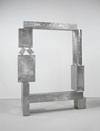I've long admired Smith, tending to think of him as a sculptor/metalworker who crafted chunky sculptures, many of them best-suited to outdoor display.

David Smith
Cubi I, 1963. Stainless steel, 124 x 34 1/2 x 33 1/2 inches. Detroit Institute of Arts, Founders Society Purchase, Special Purchase Fund. Photo: ©2005 Detroit Institute of Arts.

David Smith
Cubi XXVII, 1965. Stainless steel, 111 3/8 x 87 3/4 x 34 inches. Solomon R. Guggenheim Museum, New York, By exchange, 1967. Photo: David Heald, ©The Estate of David Smith, Licensed by VAGA, New York, NY.
But one thing I learned at the Guggenheim--to my delight--was that Smith (1906-1965) was much more versatile than that. Over the course of his career he created other types of sculptures. In some, he cut grooves through the metal in such a way that the reflected light of the museum walls seems integral to the work--this "papercut" technique wouldn't be even half as effective in many outdoor settings.
Another phase of his work incorporates Greek letters as sculptural elements.

David Smith
The Letter, 1950. Welded steel, 37 1/2 x 25 x 12 inches. Munson-Williams-Proctor Arts Institute, Museum of Art, Utica, New York. Photo: David Revette Photography, Inc., Syracuse, New York.
The entire exhibition is very well-arranged, giving the impression that curator Carmen Giménez had access to so many worthy Smith works (including samples of the artist's non-sculptural output) that she could subdivide them sensibly by room and floor section without using "filler" or forcing too many works into a limited space.

David Smith
Pillar of Sunday, 1945. Painted steel, 31 x 16 5/8 x 9 1/2 inches (78.7 x 42.2 x 8.9 cm). Indiana University Art Museum, Bloomington. Photo: Michael Cavanagh and Kevin Montague
My one quibble (of course I have to have one) is that the exhibit starts at the ground floor of the museum and spirals upward. I understand from one of my readers that this is a standard arrangement at the Guggenheim--I guess I've been in denial about it for years. Wouldn't it be better for visitors start moving through the exhibit at the top of the museum and work their way down? That's what I did, even though it meant going through the exhibition in reverse order. Silly Guggenheim!

David Smith
Voltri VII, 1962. Steel, 85 x 122 x 43 1/2 inches. National Gallery of Art, Washington, D.C., Ailsa Mellon Bruce Fund. Photo: ©The Board of Trustees, National Gallery of Art, Washington, D.C.

David Smith
Voltri XII, 1962. Steel, 86 3/4 x 49 3/4 x 13 1/2 inches. Private collection, Atherton, California. Photo: David Heald, ©The Estate of David Smith, Licensed by VAGA, New York, NY.
Here's Scoboco on the Smith show.




No comments:
Post a Comment